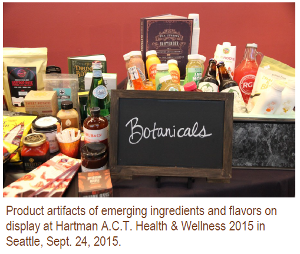More Than Merely Trend Watchers: How We ID Emerging Ingredients and Flavors
 Peas and crickets as protein. Botanical flavorings in beer and other beverages. All things “plant-based.” Ever wonder how The Hartman Group is so adept at spotting trends in areas like emerging ingredients?
Peas and crickets as protein. Botanical flavorings in beer and other beverages. All things “plant-based.” Ever wonder how The Hartman Group is so adept at spotting trends in areas like emerging ingredients?
If you ever had the opportunity to attend a Hartman A.C.T. (Anthropology. Culture. Trends.) event, then you’ve experienced firsthand The Hartman Group’s signature trend identification process. At the A.C.T. Health & Wellness 2015 symposium in Seattle, for instance, we covered a wide range of topics, including how progressive health and wellness consumers are redefining food culture, brand disruptor CPG case studies in the health and wellness space and how emerging ingredients, flavors and cuisines are determined. This popular session described new forms of protein (pea-based and insects), botanical and plant-based flavors and emerging grains (millet and popped grains) and introduced Peruvian cuisine as a global trend to follow.
At the heart of the A.C.T. sessions is an in-depth discussion about how The Hartman Group determines what emerging food and beverages are—going beyond just that sense of “you know it when you see it.” While our social scientists and research analysts listen closely to mainstream consumers (who are good indicators of when an ingredient is well on its way to mainstream acceptance), they also keep close tabs on the key players who spark trends. These influencers are followed closely to observe the products and ingredients they’re playing with, and we refer to them as the “cultural apparatus.” Notably, they include medical professionals, athletes, activists, spiritual leaders, chefs, retailers and upstart food and beverage manufacturers.
We also focus keenly on the products themselves. From our many years watching for emerging trends, we’ve come to realize that it is only those products with values deeply embedded in modern food culture that truly resonate with consumers and therefore are the most likely to survive in the mainstream. This is why it is important to keep tabs on products with a certain appeal to monitor for any change to their story, form or availability.
Three essential criteria our analysts use to determine if ingredients, flavors and cuisines are moving mainstream as trends include the applicability and relevance of:
- Ingredient and Cuisine Narratives. What is their cultural relevance?
- Ingredient Formulation and Use. Do consumers have to prepare it? Does it look weird?
- Ingredient Sourcing Potential and Distribution. Is it widely available at mainstream stores?
Finally, we watch for a “sense of intrigue” from the mainstream consumer.
Here are three emerging ingredients and flavors highlighted at the A.C.T. Health & Wellness 2015 event:
Pea Proteins
Pea protein is a “natural” candidate for meat (and egg) analogues: it's a key player in the “less meat,” “soy-free” movement. As a powder, pea protein is finding its way into sports and body-building drinks. Consumers with food allergies in their households view pea proteins as low-risk, safe and progressive options. We're seeing pea proteins in a variety of “plus protein” items, such as pasta, cereals and bars. Pea protein in meat analogues offers a way to switch away from eating meat without really changing one’s diet for new or part-time vegetarians. Companies like Beyond Meat and Impossible Foods hope to convert consumers to a more sustainable, animal-friendly form of protein by formulating products with pea proteins in mind.
Insect Proteins
 Crickets are currently the most common source of insect protein. Commonly found in Oaxaca, Mexico, fried crickets are making their way onto menus at a variety of eateries, with a greater focus in the Los Angeles area (known as the chapulín capitol of the U.S.). Crickets still have a long way to go before they are accepted into the mainstream. At the same time, products like bars and treats made with cricket flour are starting to seem a little less “out there” and are incorporating non-threatening flavors: this stems from the notion that once crickets have been ground up into flour, they aren’t quite so threatening, and consumers find that it’s easier to feel good about participating in a product they find healthy, sustainable and “adventurous.”
Crickets are currently the most common source of insect protein. Commonly found in Oaxaca, Mexico, fried crickets are making their way onto menus at a variety of eateries, with a greater focus in the Los Angeles area (known as the chapulín capitol of the U.S.). Crickets still have a long way to go before they are accepted into the mainstream. At the same time, products like bars and treats made with cricket flour are starting to seem a little less “out there” and are incorporating non-threatening flavors: this stems from the notion that once crickets have been ground up into flour, they aren’t quite so threatening, and consumers find that it’s easier to feel good about participating in a product they find healthy, sustainable and “adventurous.”
Botanicals in Beverages
Continuing on our plant-based theme, we are seeing increasing signs of diverse botanicals, with their highly varied flavors, aromas, histories and health properties, appearing in adventurous combinations in foods and, notably, beverages. From a traditional health and wellness perspective, consumers see botanicals as known ingredients, offering a “back to nature” approach to promoting a range of wellness states, based in historical wisdom ranging from digestion to detox. As artificial flavors and colors continue to decline in popularity, consumers are increasingly open to the novel, fresh, seasonal and bright flavors of botanicals as a flavor agent in beverages ranging from cocktails and craft beer to RTD beverages and functional drinks. Driven by chefs, mixologists and the modern juice category, botanicals are being included for flavor, discovery and functional benefits.
What does the future look like for the food and beverage industry? You can get the answer by attending the next A.C.T. event, Food Culture Forecast 2016, in Nashville on April 7, 2016. View the agenda, speaker lineup and information about the venue, and register by visiting the event website: A.C.T. Nashville
